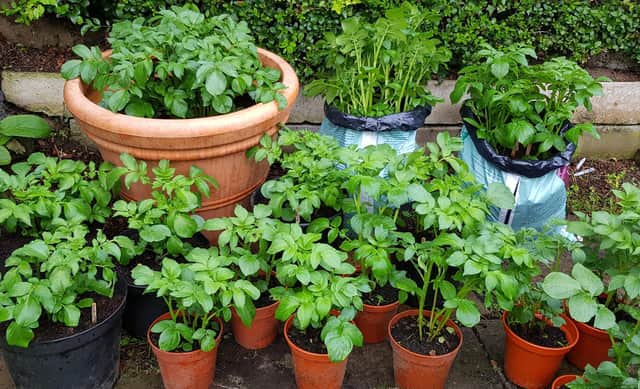GARDENING:


This-fellow plans both these treats as part of the gardening year. Potatoes take circa ten weeks from planting to digging for the kitchen.
This time frame varies according to environmental conditions but does offer a guide when planning the next treat.
Advertisement
Hide AdAdvertisement
Hide AdSo, when we plant “first early” types in mid-to late March the expectation is that they`ll be ready by Mid-June. “Second early” varieties are planted at the same time and mature as we enter July. Early and late “main crop” varieties are planted in April and mature from August and September onwards respectively.
Three varieties I am presently cultivating for late autumn and winter use also have a name type. They are termed “second cropping,” and are tubers of popular cultivars that have been subjected to cold storage.
`Charlotte` (main crop) is a favourite that performs so well outside the normal growing season. Introduced in 1981, it's a French variety of long oval shape and yellow skin, bred for the salad potato market. `Nicola` (second early) joined the scene in 1973. A long, oval type with yellow flesh, a strong point is the size it achieves in reasonable compost or soil. `Maris Peer` (1962) is a second early potato with white skin and round-oval shape. The tubers are of medium size but there are plenty on the haulm.
When these three varieties arrived from D.T.Brown (dtbrownseeds.co.uk) in late July, They were placed in trays, eyes upward, to encourage chitting. Some were introduced, three to a two-litre pot, in August and transferred outdoors. Subsequent potting-on has them currently in bigger pots and bags. They`ll stay outside until the October/November weather change, then go into the unheated greenhouse. Meanwhile, a second batch of chitted tubers have gone into first pots. They will offer continuity up to and beyond Christmas.
Advertisement
Hide AdAdvertisement
Hide AdNo garden? No problem! When growing them out of season I use a range of different containers; large pots, tubs, empty compost bags or grow-bags. And if you can`t source prepared, second cropping tubers, examine any potatoes in store for kitchen use. I put some aside in the garage as autumn arrives and come January, they've started to shoot. They are transferred to
pots and compost in the unheated greenhouse and we`re on track for new potatoes at Easter!
What a glorious start to autumn it was last week. The sunlight brought certain herbaceous perennials out of their shells and they revelled under its warmth. This in turn attracted our favourite insects so highlight of the week was observing the movement of butterfly and bee species as they flitted between flowers. Sedum spectabile, Rudbeckia `Goldsturm,` `Helenium
`Moorheim Beauty` and various echinacea lead the way in attracting these beauties to our gardens.
Advertisement
Hide AdAdvertisement
Hide AdEach of these precious plants is easily propagated by dividing up large clumps into sections. Best time for this is late October or early spring just as new growth is starting, but it's also possible throughout winter in the absence of frost. Raising them all from seed is another option. Sedum has such fleshy leaves that they almost shout out their rooting potential. Fill a tray with damp, gritty sand, and plant them upright to half their depth. Cover the tray with a transparent domed top, then stand it undercover where there is good light and warmth.
Two popular autumn bulbous plants emerged recently to join this early autumn display. Colchicum (autumn crocus) suddenly broke the surface last week alongside the dwarf Cyclamen hederifolium. Both should already be on display at your local garden centre as time to plant for spring approaches.
With this in mind, we`ve been monitoring the progress of primula, polyanthus and wallflower plants saved from last spring`s bedding displays.
The first two mentioned might need further dividing up before planting, but the wallflowers were severely pruned in May and have responded strongly so we`ll get one more display from them. Apart from saving the seed, they can also be rooted from softwood cuttings, ensuring we get value for money from every plant!